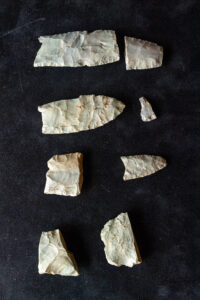Clovis Camp Site Discovered In St. Joseph County, Thought To Be Earliest Archaeological Site In Michigan
(CBS DETROIT) - Independent researcher Thomas Talbot and researchers from the University of Michigan have discovered a 13,000-year-old Clovis camp site in St. Joseph County and it is now thought to be the earliest archaeological site located in Michigan.
In an article by the University of Michigan, it was explained that at the time of the Clovis people, the location of the site, and most of Michigan, were covered in glaciers. Because of this, the site was uninhabitable besides being visited for fishing trips.
For a little bit of background information, the Clovis people lived in the Americas between 13,000 and 12,500 years ago, and this prehistoric Paledonian culture is identified by the tools they used.
The Clovis tools are made out of a stone called chert, have channels that go through the center of the tools, and large areas of the tool were chipped off to create the point.
Independent researcher Thomas Talbot searches the fields each year after they have been plowed during the spring and has done so for 10 years. He found the first Clovis spear point in 2008 and had found nine pieces since then.
 Independent researcher Thomas Talbot and University of Michigan archeologists have found more than 20 Clovis tools and hundreds of pieces of manufacturing and refurbishment debris at the Belson Clovis Site in St. Joseph County. Image credit: Daryl Marshke/Michigan Photography
Independent researcher Thomas Talbot and University of Michigan archeologists have found more than 20 Clovis tools and hundreds of pieces of manufacturing and refurbishment debris at the Belson Clovis Site in St. Joseph County. Image credit: Daryl Marshke/Michigan Photography
"Paleolithic pieces—not quite this old, but pieces that are similar—have turned up around Michigan, but usually they are pretty scattered like maybe someone lost it while they were hunting or walking through," Talbot said to the University of Michigan. "So although I thought it was really cool, I thought it was a once-in-a-lifetime finding. But other pieces started turning up, and by the end of the spring, it was pretty clear that I had Clovis components at this site."
After finding multiple pieces at the site, the article says that Talbot reached out to Henry Wright and Brendan Nash, archaeologists at the University of Michigan, to show them his findings and have them take a look at the area.
"Last year, with Brendan's expertise and Henry's guidance, we opened up the site and found two distinct artifacts well below the plow zone, which means they're undisturbed. They've laid there for 13,000 years," Talbot said to the University of Michigan. "That tells us we have at least a partially undisturbed Clovis component in Michigan, and that's huge. That's very big news that changes archaeology for the state of Michigan."
Since discovering the site, they have found over 20 tools and hundreds of pieces of stone debris from when the tools were made.
For more information and images about this discovery, visit the article published by the University of Michigan. For more details about their findings, visit the paper that Nash, Talbot, and Wright published in the PaleoAmerica journal.
© 2021 CBS Broadcasting Inc. All Rights Reserved. This material may not be published, broadcast, rewritten, or redistributed.



